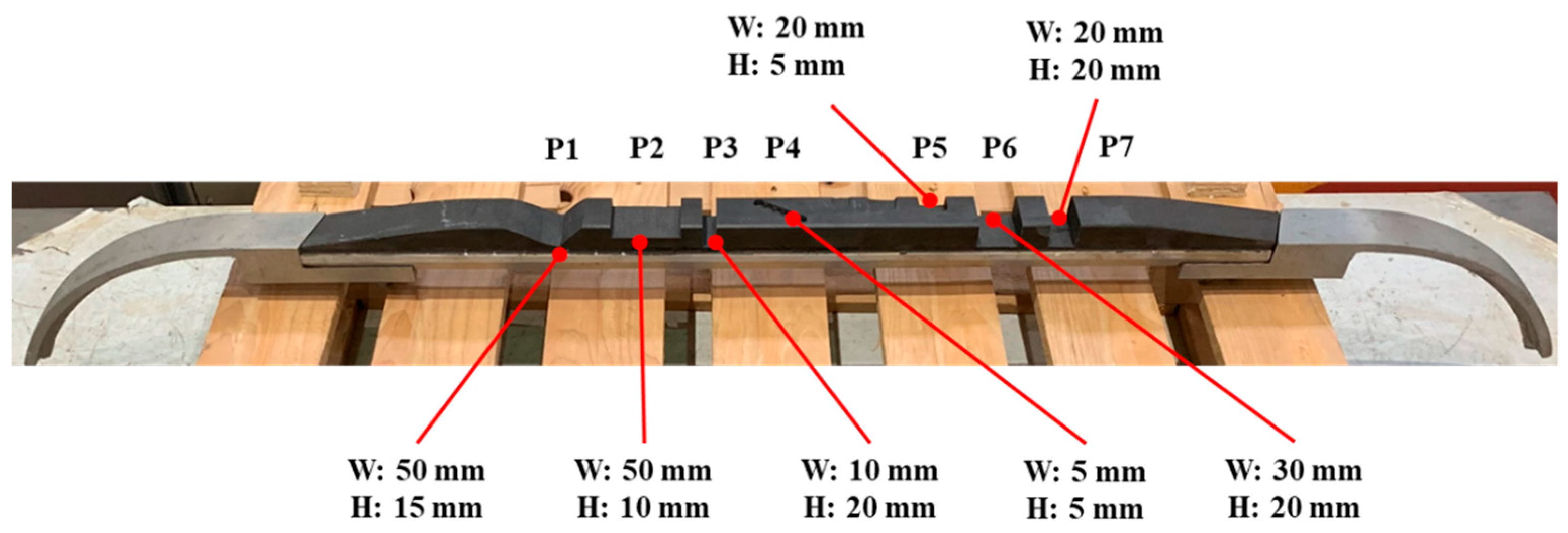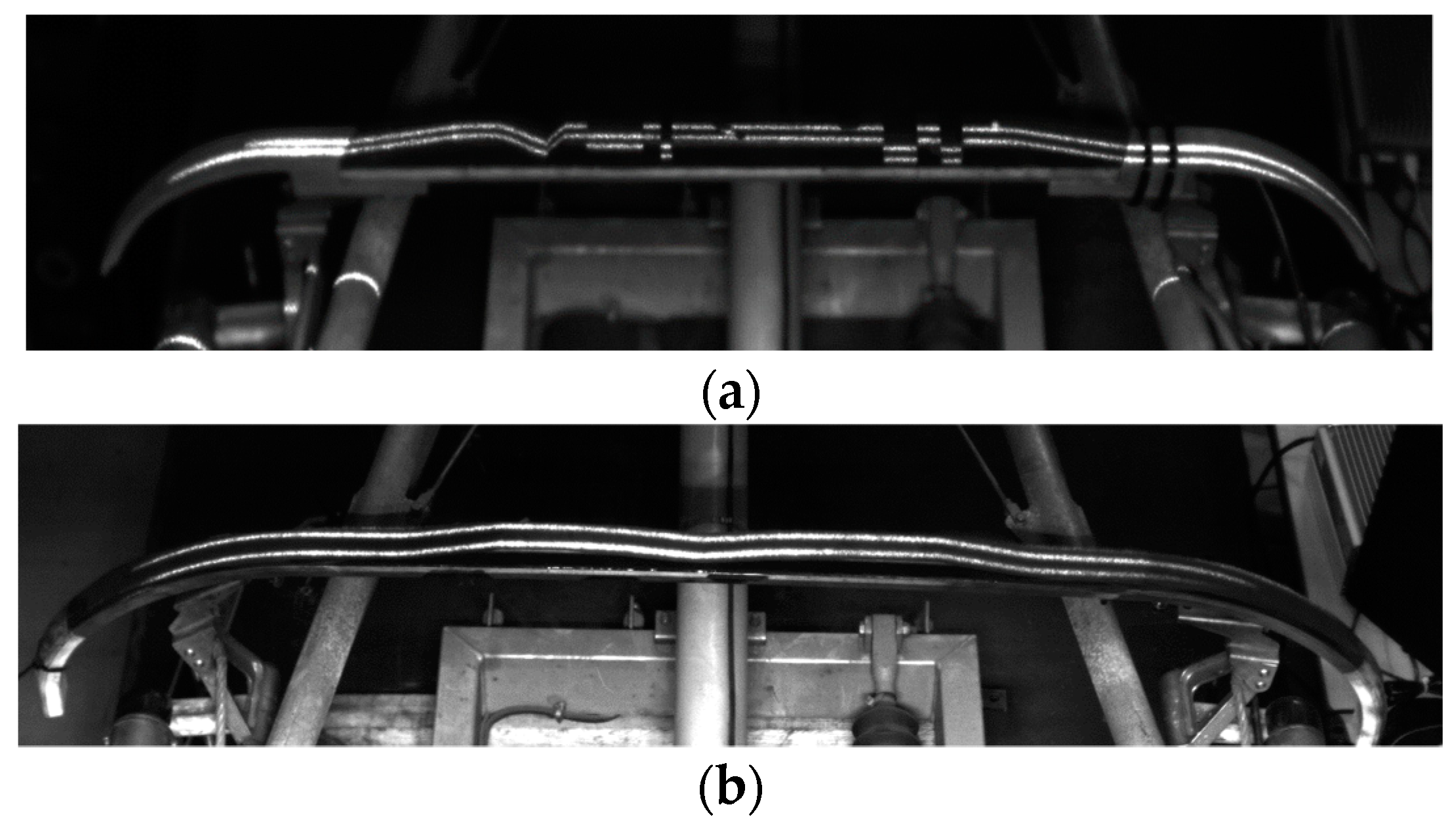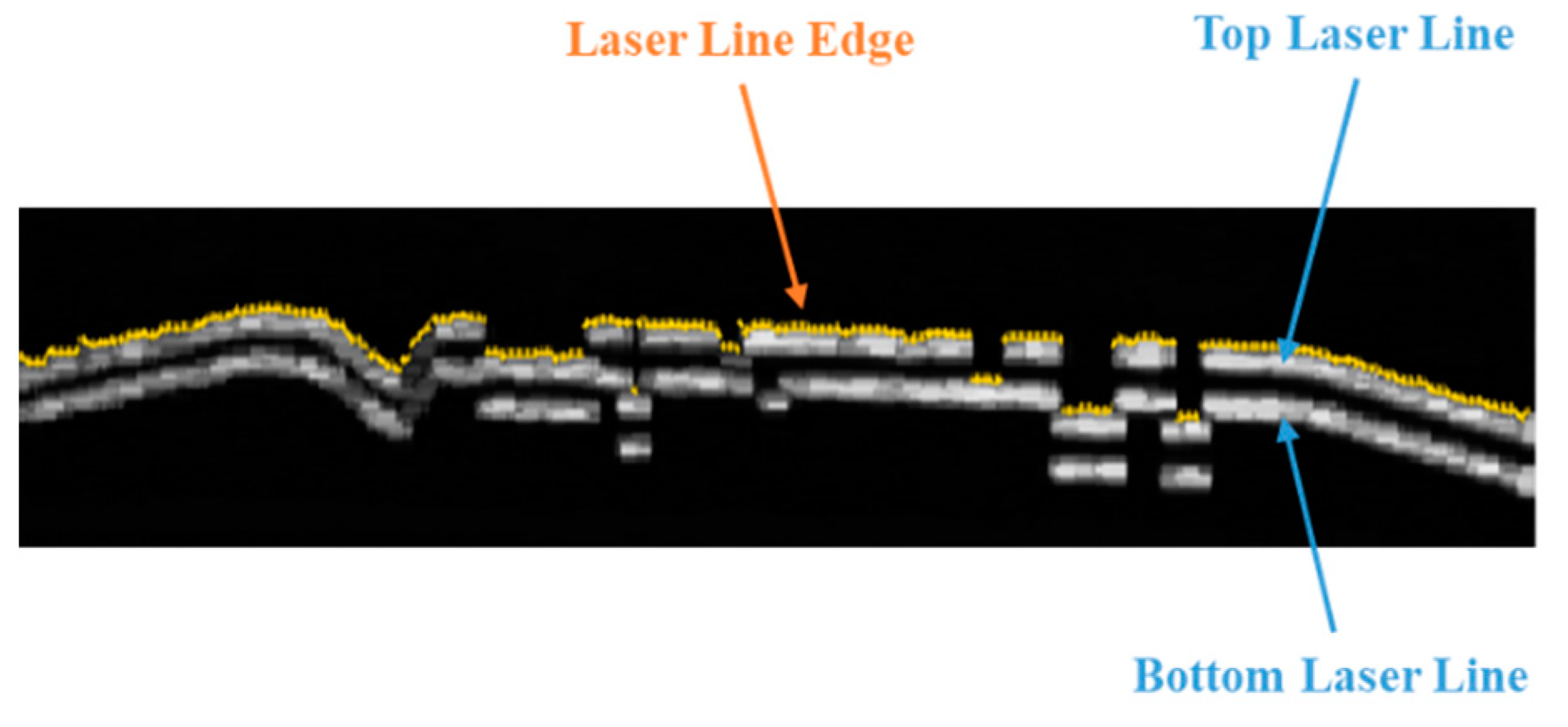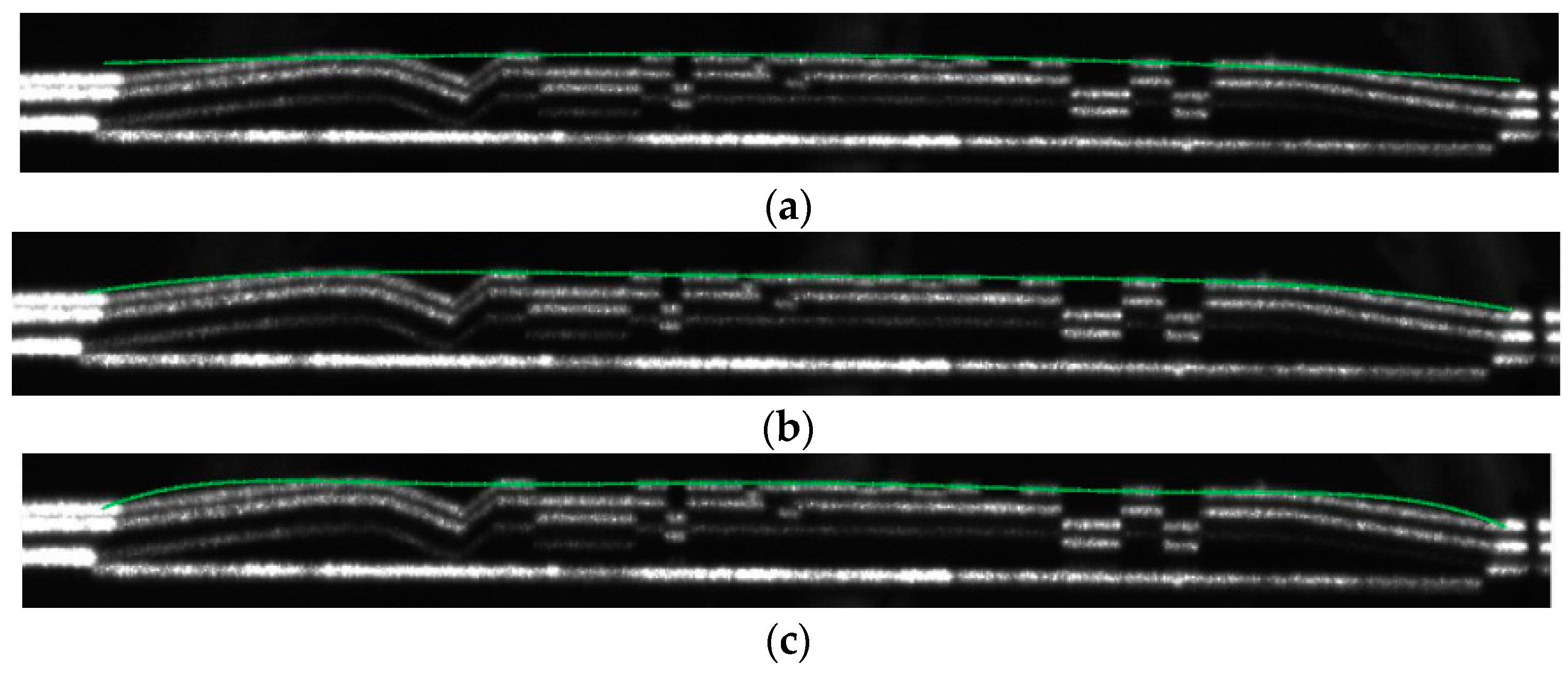Detecting Deformation on Pantograph Contact Strip of Railway Vehicle on Image Processing and Deep Learning
Abstract
:1. Introduction
2. Materials and Methods
2.1. Contact Strip of the Pantograph
2.2. Monitoring Equipment for the Pantograph
2.3. Wear Measurement Algorithm for the Contact Strip
2.3.1. Deep-Learning for ROI Detection
2.3.2. Image Processing for Wear Measurement
3. Results
4. Conclusions
Author Contributions
Funding
Acknowledgments
Conflicts of Interest
References
- Kim, H.; Sultana, S. The impacts of high-speed rail extensions on accessibility and spatial equity changes in South Korea from 2004 to 2018. J. Transp. Geogr. 2015, 45, 48–61. [Google Scholar] [CrossRef] [Green Version]
- Kang, G.; Jung, I.; Kim, J.-y.; Seo, M. Preliminary Study on the Simulation for Urban Railway Facility Performance Assessment. J. Korea Acad. Ind. Coop. Soc. 2020, 21, 190–198. [Google Scholar]
- Femine, A.D.; Gallo, D.; Giordano, D.; Landi, C.; Luiso, M.; Signorino, D. Power Quality Assessment in Railway Traction Supply Systems. IEEE Trans. Instrum. Meas. 2020, 69, 2355–2366. [Google Scholar] [CrossRef]
- Song, Y.; Liu, Z.; Lu, X. Dynamic Performance of High-Speed Railway Overhead Contact Line Interacting With Pantograph Considering Local Dropper Defect. IEEE Trans. Veh. Technol. 2020, 69, 5958–5967. [Google Scholar] [CrossRef]
- Na, K.-M.; Lee, K.; Kim, H.; Cho, C.J.; Choi, W.; Park, Y. Implementation of Image Processing in Studying Contact Conditions of Overhead Contact Line-Pantograph at 400 km/h. J. Electr. Eng. Technol. 2020, 15, 989–995. [Google Scholar] [CrossRef]
- Yang, H.; Wang, K.; Liu, Y.; Fu, L.; Cui, X.; Jiang, G.; Hu, B. The formation of the delamination wear of the pure carbon strip and its influence on the friction and wear properties of the pantograph and catenary system. Wear 2020, 203343. [Google Scholar] [CrossRef]
- Ostlund, S.; Gustafsson, A.; Buhrkall, L.; Skoglund, M. Condition monitoring of pantograph contact strip. In Proceedings of the 4th IET International Conference on Railway Condition Monitoring (RCM 2008), Derby, UK, 18–20 June 2008; p. 37. [Google Scholar]
- Wei, W.; Wu, J.; Gao, G.; Gu, Z.; Liu, X.; Zhu, G.; Wu, G. Study on Pantograph Arcing in a Laboratory Simulation System by High-Speed Photography. IEEE Trans. Plasma Sci. 2016, 44, 2438–2445. [Google Scholar] [CrossRef]
- Kim, J.-M.; Kim, Y.-S. Network Design for Construction of Remote Diagnosis System for Power Facilities of Electric Railway. Trans. Korean Inst. Electr. Eng. 2009, 58, 432–436. [Google Scholar]
- Bucca, G.; Collina, A. A procedure for the wear prediction of collector strip and contact wire in pantograph–catenary system. Wear 2009, 266, 46–59. [Google Scholar] [CrossRef]
- Zhang, H.; Luo, L.; Yang, K.; Wang, L.; Gao, X. Improved multi-scale wavelet in pantograph slide edge detection. Optik 2014, 125, 5681–5683. [Google Scholar] [CrossRef]
- Lu, S.; Liu, Z.; Li, D.; Shen, Y. Automatic wear measurement of pantograph slider based on multi-view analysis. IEEE Trans. Ind. Inform. 2020, 1. [Google Scholar] [CrossRef]
- Huang, S.; Zhai, Y.; Zhang, M.; Hou, X. Arc detection and recognition in pantograph–catenary system based on convolutional neural network. Inf. Sci. 2019, 501, 363–376. [Google Scholar] [CrossRef]
- Balestrino, A.; Bruno, O.; Landi, A.; Sani, L. Automatic processing analysis of infrared images for monitoring pantograph catenary interactions. Comput. Methods Exp. Meas. XIII 2007, 46, 819–828. [Google Scholar] [CrossRef] [Green Version]
- Aydin, I.; Karakose, M.; Akin, E. A New Contactless Fault Diagnosis Approach for Pantograph-Catenary System Using Pattern Recognition and Image Processing Methods. Adv. Electr. Comput. Eng. 2014, 14, 79–88. [Google Scholar] [CrossRef]
- Zhang, Y.; Yang, K.; Wyant, J.C.; Wang, L.; Gao, X.; Smythe, R.A.; Wang, H.; Zhao, Q.; Wang, Z.; Peng, C. Application of CCD measurement technique for wear on pantograph sliding plates. In Proceedings of the 4th International Symposium on Advanced Optical Manufacturing and Testing Technologies: Optical Test and Measurement Technology and Equipment, Chengdu, China, 19–21 November 2008. [Google Scholar]
- Karakose, E.; Gencoglu, M.T.; Karakose, M.; Aydin, I.; Akin, E. A New Experimental Approach Using Image Processing-Based Tracking for an Efficient Fault Diagnosis in Pantograph–Catenary Systems. IEEE Trans. Ind. Inform. 2017, 13, 635–643. [Google Scholar] [CrossRef]
- Doyle, S.; Bastucescu, C.; Vale, T. Pantograph condition monitoring system for automated maintenance inspections and prevention of overhead wiring tear downs. In Proceedings of the CORE 2016: Conference on Railway Excellence (CORE 2016), Victoria, Australia, 16–18 May 2016; pp. 178–187. [Google Scholar]
- Zhang, Z. A flexible new technique for camera calibration. IEEE Trans. Pattern Anal. Mach. Intell. 2000, 22, 1330–1334. [Google Scholar] [CrossRef] [Green Version]
- Wei, X.; Jiang, S.; Li, Y.; Li, C.; Jia, L.; Li, Y. Defect Detection of Pantograph Slide Based on Deep Learning and Image Processing Technology. IEEE Trans. Intell. Transp. Syst. 2019, 21, 947–958. [Google Scholar] [CrossRef]
- Deng, G.; Cahill, L. An adaptive Gaussian filter for noise reduction and edge detection. In Proceedings of the 1993 IEEE conference record nuclear science symposium and medical imaging conference, San Francisco, CA, USA, 31 October–6 November 1993; pp. 1615–1619. [Google Scholar]
- Shih, F.Y.; Cheng, S. Adaptive mathematical morphology for edge linking. Inf. Sci. 2004, 167, 9–21. [Google Scholar] [CrossRef]
- Hinz, S. Fast and subpixel precise blob detection and attribution. Proceedings of IEEE International Conference on Image Processing 2005, Genova, Italy, 14–16 September 2006; p. III-457. [Google Scholar]



















| Equipment | Specifications | Contents | Manufacturer |
|---|---|---|---|
| Near Infrared Ray (NIR) camera | Resolution | 2048(H) × 1088(V) | Allied Vision, Pennsylvania, USA |
| Pixel size | 5.5 µm × 5.5 µm | ||
| ADC (Analog to Digital Converter) | 12 bit | ||
| Line laser sensor | Wavelength | 635 nm to 980 nm | Z-Laser, Freiburg, Germany |
| Gaussian profile (Line) | 3° to 90° | ||
| Homogeneous intensity profile (Line) | 10° to 90° | ||
| Trigger sensor | Response time | 1.5 ms to 256 ms | Banner, Minnesota, USA |
| Resolution | <0.3 ms to 4 ms | ||
| Sensing range | 50 mm to 24,000 mm |
| Intrinsic Parameters | x | y |
|---|---|---|
| Focal length (pixels) ± Error range | 2867.3350 ± 17.0844 | 2861.6535 ± 16.9425 |
| Principal point (pixels) | 1453.0524 ± 22.0096 | 332.7520 ± 15.5928 |
| Skew coefficient | −2.3252 ± 2.1299 | |
| Item | P1 | P2 | P3 | P4 | P5 | P6 | P7 |
|---|---|---|---|---|---|---|---|
| Width | 9.04 mm | 1.45 mm | 2.01 mm | 1.99 mm | 2.11 mm | 1.03 mm | 2.02 mm |
| Height | 4.01 mm | 2.01 mm | 6.01 mm | 2.00 mm | 4.99 mm | 5.02 mm | 5.02 mm |
Publisher’s Note: MDPI stays neutral with regard to jurisdictional claims in published maps and institutional affiliations. |
© 2020 by the authors. Licensee MDPI, Basel, Switzerland. This article is an open access article distributed under the terms and conditions of the Creative Commons Attribution (CC BY) license (http://creativecommons.org/licenses/by/4.0/).
Share and Cite
Na, K.-M.; Lee, K.; Shin, S.-K.; Kim, H. Detecting Deformation on Pantograph Contact Strip of Railway Vehicle on Image Processing and Deep Learning. Appl. Sci. 2020, 10, 8509. https://doi.org/10.3390/app10238509
Na K-M, Lee K, Shin S-K, Kim H. Detecting Deformation on Pantograph Contact Strip of Railway Vehicle on Image Processing and Deep Learning. Applied Sciences. 2020; 10(23):8509. https://doi.org/10.3390/app10238509
Chicago/Turabian StyleNa, Kyung-Min, Kiwon Lee, Seung-Kwon Shin, and Hyungchul Kim. 2020. "Detecting Deformation on Pantograph Contact Strip of Railway Vehicle on Image Processing and Deep Learning" Applied Sciences 10, no. 23: 8509. https://doi.org/10.3390/app10238509




